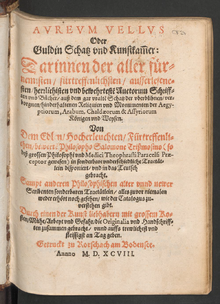Salomon Trismosin
Salomon Trismosin , also Trissmosin, was a legendary German alchemist of the 15th and 16th centuries.
He enjoyed a reputation in his day as an outstanding alchemist who also knew the secret of the Philosopher's Stone , and he is said to have written the collection of alchemical writings Aureum Vellus (or Guldin Schatz und Kunstkamer) (Das Goldene Viess) (Das Goldene Vloss) around 1490 , which was first published in 1598 in Rorschach was printed. A second part was published in Basel in 1604 and new editions in Hamburg in 1708 and 1718 . The name comes from the legend of the golden fleece , which, according to tradition, contained instructions for making gold. The text also contains writings by Paracelsus (and a woodcut of the same), the Tabula Smaragdina , a text by Avicenna , texts by a certain Korndorff and by Bishop Melchior von Brixen, texts by unknown authors and by Trismosin the text Splendor Solis, among others . Trismosin was allegedly the teacher of Paracelsus (whom he allegedly met in Constantinople) and most likely (e.g. Hermann Kopp suspected that ) it is a fictional figure by an anonymous author in southwest Germany in the second half of the 16th century, the To give more meaning to the writings of Paracelsus. Other writings were also distributed under his name.
According to his own statements in the opening tract of the Aureum Vellum , he first came into contact with alchemy when he saw a transmutation of a miner and alchemist named Flocker. In order to discover the secret, he went on a journey from 1473, especially to Italy, where he met a Jew who apparently turned tin into silver and sold it as such. He became his assistant and came with him to Venice. When he wanted to sell the supposed silver there for his own account and had it tested beforehand, it turned out to be wrong. Thereupon he left the Jew and worked for a time as a laboratory technician in a large chemical laboratory of a nobleman outside Venice that had a German chief chemist named Tauler. That ended when his employer was killed at the Festa della Sensa when a storm caught the boats by surprise. From Venice he traveled to the Orient, where he got to know Arabic alchemical books which he had translated into Greek and Latin and which would have revealed the secret of the Philosopher's Stone.
According to the aureum vellus, the philosopher's stone is obtained by subliming mercury with alum , saltpeter and table salt and multiple distillation with alcohol (finally with the addition of gold leaf). With the Philosopher's Stone he not only turned base metals into gold, but also became younger.
An alchemical picture treatise Splendor Solis was also (incorrectly) ascribed to him (first in the French edition 1612).
literature
- Bernhard Lepsius : Trismosin, Salomon . In: Allgemeine Deutsche Biographie (ADB). Volume 38, Duncker & Humblot, Leipzig 1894, p. 625 f.
- John Ferguson: Bibliotheca Chemica, Glasgow 1906, Volume 2, p. 469 (Salomon Trissmosin)
- Wilhelm Kühlmann, Joachim Telle (Ed.): Der Frühparacelsismus, Tübingen 2004, p. 219ff
Web links
Individual evidence
- ↑ Kühlmann, Telle Frühparacelsismus , 2004, p. 220
| personal data | |
|---|---|
| SURNAME | Trismosin, Solomon |
| BRIEF DESCRIPTION | Alchemist |
| DATE OF BIRTH | 15th century |
| DATE OF DEATH | 16th Century |
